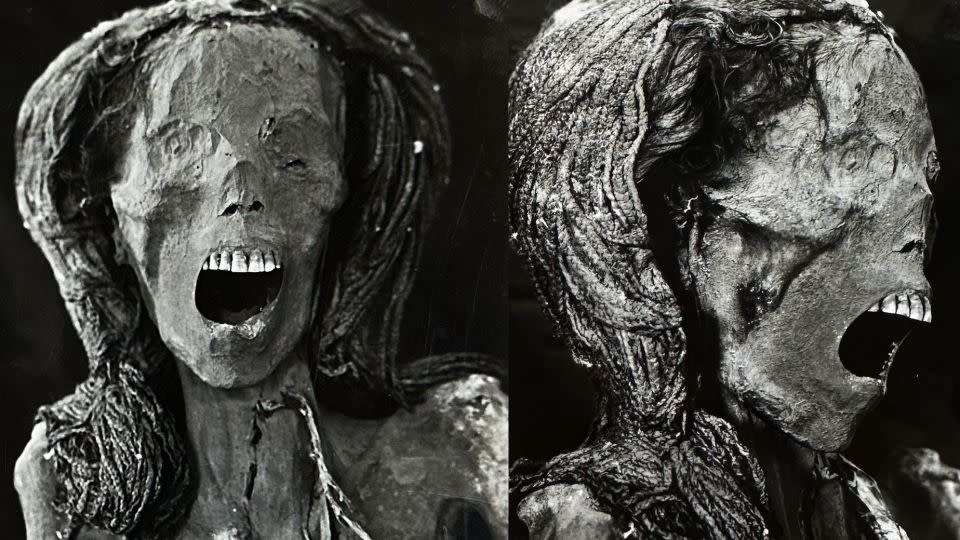Editor’s Note: A version of this story appeared in CNN’s Wonder Theory science newsletter. To get it in your inbox, Sign up for free here.
The pyramids, pharaohs and artefacts of ancient Egypt capture the imagination and rekindle the wonder of the distant past in every generation.
Today, archaeologists continue to make fascinating discoveries in the Nile Valley. An expedition to Damietta, Egypt, recently unearthed 63 tombs dating back more than 2,500 years, as well as a wealth of coins, gold objects and pottery.
Experts are also using cutting-edge technology to uncover secrets hidden in discoveries made decades ago. This week, for example, new research was conducted to “digitally dissect” an unusual mummy found in 1935.
A long time ago

With her mouth open, the mummified woman appears to be forever locked in a heart-rending scream, as evidenced by the archaeologists who originally found her remains in a tomb near Luxor during an expedition led by the Metropolitan Museum of Art in New York City nearly a century ago.
What could have caused this disturbing facial expression?
To solve the mystery, Sahar Saleem, a professor of radiology at Cairo University’s Kasr Al Ainy Hospital, used CT scans to reveal details about the woman’s morphology, health conditions and preservation. Infrared imaging and other advanced techniques also helped shed more light on her life.
The woman was 48 years old when she died, and strangely enough, her organs were still inside the body, contrary to typical burial rituals, Saleem discovered. Although Saleem could not determine an exact cause of death, the information she gathered led to a gruesome hypothesis.
Other worlds
Scientists believe the solar system’s smallest planet could be hiding a layer of diamonds up to 18 kilometers (11 miles) thick. According to a recent study, it may have formed shortly after Mercury merged into a planet, about 4.5 billion years ago.
To understand how the diamonds could have formed, researchers conducted an experiment using a huge machine called an anvil press and a synthetic mixture of elements that mimicked the supposed composition of Mercury’s early interior.
The research team found that one of the ingredients, graphite, a form of carbon, turned into diamond crystals under those conditions. Without samples from the planet’s surface, it’s not possible to know for sure whether the same process occurred there.
However, a mission led by the European Space Agency and the Japanese Aerospace Exploration Agency, called BepiColombo, expected to orbit Mercury next year, could tell scientists more.
Discoveries


Venus is sometimes called Earth’s evil twin because of its surface temperatures that can melt lead and clouds of corrosive sulfuric acid. It may be the place in the solar system least conducive to life.
However, scientists have discovered two gases, phosphine and ammonia, that are considered biomarkers of life on Earth.
Four years ago, when phosphine was first unexpectedly discovered in the clouds of Venus, the discovery sparked controversy. Now scientists say they have stronger evidence that phosphine is present and have detected ammonia.
The results are preliminary and must be independently confirmed, but they make future missions and flybys to Venus, such as the Jupiter Icy Moons Explorer and DAVINCI, particularly important and exciting.
We are family
Homo sapiens, our own species, shared the planet with Neanderthals, the archaic humans who lived in Europe and much of Asia, for at least 250,000 years.
There is still a mystery as to why Neanderthals became extinct while early modern humans dominated and inhabited the Earth.
A new analysis of ancient DNA shows that there were multiple waves of interbreeding between the two groups. These population dynamics may have caused the Neanderthal population to become smaller and less diverse over time, as their gene pool was absorbed into the modern human population.
Some genes we inherited from our Neanderthal ancestors still influence our lives.
Once upon a time on a planet


“Every rose has its thorn,” sang glam metal band Poison in their famous 1980s power ballad. But a new discovery by geneticists may open the door to thorn-free roses.
The spiky features protrude from the stems to ward off animals looking for a snack. They are defense mechanisms that are also found in many other plants, such as tomatoes, eggplants, barley and rice sprouts. These plants have evolved over 400 million years.
A new study has identified an ancient family of genes responsible for the trait, Lonely Guy or LOG, that could be targeted with gene editing techniques. Removing spines could make picking and harvesting easier and bring lesser-known produce to supermarket shelves.
Explorations
Dive deeper into these fascinating findings.
—An insect-like sea creature that lived half a billion years ago looked a bit like a taco and had one key feature shared by many animals today and another that still puzzles researchers.
— Scientists have discovered unexpected X- and C-shaped structures in the atmosphere and are trying to explain them.
— To keep swimmers and beachgoers safe, scientists are using artificial intelligence to detect young sharks that like to hang out near shore.
—A forest complex in Thailand offers new hope for endangered tigers in Southeast Asia.
Do you like what you’ve read? Oh, but there’s more. Register here to receive the next edition of Wonder Theory in your inbox, brought to you by CNN Space and Science writers Ashley Strickland And Katie HuntThey find wonder in planets beyond our solar system and discoveries from ancient times.
For more CNN news and newsletters, create an account at CNN.com